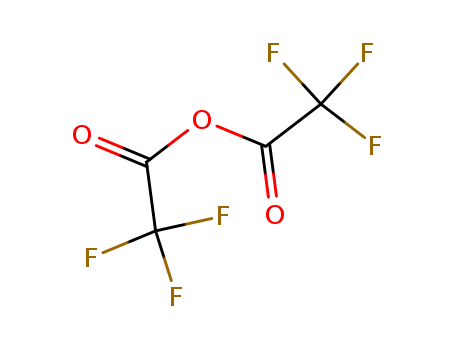10.1002/jhet.5570320532
The research focuses on the synthesis and reactivity of N-protected pyroglutamic derivatives, specifically pyroglutamoyl chlorides N-protected by a methoxycarbonyl or a trifluoroacetyl group. The purpose of this study was to develop an easy and convenient synthesis method for these unstable compounds and to explore their reactivity, with the aim of overcoming stability issues and simplifying the deprotection process. The researchers successfully synthesized N-trifluoroacetyl and N-methoxycarbonyl pyroglutamoyl chlorides and studied their reactions with various reagents, including methanol, thionyl chloride, trifluoroacetic anhydride, and methyl chloroformate. They also investigated the condensation of these derivatives with aromatic amines and their reactions with isopropylidene malonate (Meldrum's acid). The study concluded that the protecting groups could be easily removed without opening the lactam ring, and the reactions were effectively monitored using proton nuclear magnetic resonance (1H NMR). The chemicals used in the process included pyroglutamic acid, trifluoroacetic anhydride, methyl chloroformate, thionyl chloride, and various amines, among others.
10.1055/s-1988-27513
The research focuses on the convenient synthesis of 5-aryl-6-trifluoromethyl-3,6-dihydro-2H-1,3,4-oxadiazines, a class of compounds with potential medicinal activities. The study aims to develop a novel cyclization reaction using silica gel as a catalyst to synthesize these compounds, which contain fluorine and have not been previously reported. The process involves the acylation of arenecarbonyl dimethylhydrazones with trifluoroacetic anhydride to produce trifluoroacetylated hydrazones, which then undergo cyclization to form the desired oxadiazines. The researchers successfully synthesized several 5-aryl-6-trifluoromethyl-3,6-dihydro-2H-1,3,4-oxadiazines in good yields and further demonstrated the utility of this method by hydrolytically cleaving the rings to afford α-hydroxyketones bearing the trifluoromethyl group in high yields.
10.1002/chir.20957
The study aims to develop a chiral gas chromatographic method for separating compounds involved in the EMDE synthesis of methylamphetamine, a widely abused stimulant drug. The chemicals involved include ephedrine, pseudoephedrine, chlorinated intermediates, and methylamphetamine, which are the primary compounds of interest in the synthesis process. The researchers used fluorinated acid anhydrides such as trifluoroacetic anhydride (TFAA), pentafluoropropanoic anhydride (PFPA), and heptafluorobutyric anhydride (HFBA) as chemical derivatization reagents to reduce the polarity and basicity of these compounds, thereby improving enantiomeric separations. The study focused on separating the enantiomers of these compounds using a 2,3-di-O-methyl-6-t-butyl silyl-b-cyclodextrin stationary phase (CHIRALDEXTM B-DM) in a gas chromatograph. The results showed that PFPA derivatization effectively separated the enantiomers of pseudoephedrine, methylamphetamine, and chlorinated intermediates within 40 minutes, while TFAA was used for ephedrine enantiomers. The study concludes that this method can help identify the source of starting materials and synthetic routes used in the illicit manufacture of methylamphetamine, particularly distinguishing the Emde route from other methods like Birch reduction and Nagai methods.
10.1021/jo00907a012
The research investigates the scope and limitations of the dimethyl sulfoxide-trifluoroacetic anhydride (DMSO-TFAA) reagent for the preparation of iminosulfuranes. The study aims to explore the efficiency and applicability of this reagent with various nitrogen-containing compounds, including aryl amines, amides, sulfonamides, and urea. The key chemicals used in the research are DMSO and TFAA, which form an intermediate reagent that reacts with the nitrogen compounds to produce iminosulfuranes. The research concludes that the DMSO-TFAA reagent is highly effective, yielding iminosulfuranes in 40-90% yields, and is particularly reactive even with aromatic amines containing certain ortho substituents. The study also highlights the reagent's ability to form iminosulfuranes from previously uncharacterized compounds like sulfanilamide and sulfadiazine. However, it notes limitations with relatively basic amines and certain aromatic compounds. The findings suggest that the DMSO-TFAA reagent is a valuable tool for the preparation of iminosulfuranes, offering a more efficient and versatile alternative to other activated DMSO reagents.
10.1016/j.bmcl.2004.11.046
The study focuses on the regioselective synthesis of modified proanthocyanidins by introducing acyl substituents at the C-8 position of (+)-catechin, leading to the creation of various catechin derivatives. These derivatives were utilized for further synthesis of modified proanthocyanidins, with a particular emphasis on the synthesis of a new 3-O-4 ether-linked procyanidin-like derivative. Key chemicals used in the study include tetra-O-benzyl catechin, penta-O-benzyl catechin, trifluoroacetic anhydride, and titanium tetrachloride (TiCl4) as a catalyst. These chemicals served various purposes, such as starting materials for the synthesis, reagents for acylation and electrophilic addition reactions, and a catalyst for the selective condensation reaction that led to the formation of the ether-linked procyanidin-like derivative. The study aimed to investigate the influence of substitution patterns on the behavior of these compounds in Lewis acid-catalyzed synthesis of naturally occurring procyanidins and to develop a new methodology for managing regiochemical features related to the dimerization reaction of flavan-3-ol monomers.
10.1021/acs.orglett.1c01720
The study presents an efficient method for the trifluoromethylation of benzoic acids using TMSCF3 (trimethylsilyl trifluoromethane) to produce aryl trifluoromethyl ketones. The reaction involves anhydrides as in situ activating reagents, with trifluoroacetic anhydride (TFAA) and 4-dimethylaminopyridine (DMAP) playing crucial roles in activating the carboxylic acids and facilitating nucleophilic addition. CsF (cesium fluoride) is used to enhance the yield of the desired products. The reaction is conducted in PhOMe (anisole) solvent under nitrogen at 120 °C for 15 hours. The study demonstrates a wide substrate scope, including various carboxylic acids with different functional groups, and shows high functional group tolerance. Notably, bioactive molecules such as adapalin, probenecid, and telmisartan can also be trifluoromethylated using this method, highlighting its potential in drug design and development. The reaction conditions are relatively mild, and the process is scalable, making it a practical and environmentally benign approach for synthesizing aryl trifluoromethyl ketones.
10.1021/jo00308a030
The study focuses on the synthesis of 1,4-dinitroanthracene-9,10-dione (2) and its subsequent transformations using various diamines. The researchers explored two methods for synthesizing 2, one involving trifluoroacetic anhydride and hydrogen peroxide, and the other using trifluoroacetic acid and hydrogen peroxide. They then investigated the displacement of the nitro groups in 2 by different diamines, such as N,N-dimethylethylenediamine, 2-[(2-aminoethyl)amino]ethanol, and ethylenediamine, to produce monosubstituted and bis-substituted anthracene-9,10-dione derivatives. The study also examined the sequential displacements of the nitro substituents by diamines to prepare unsymmetrically substituted 1,4-bis[(aminoalkyl)amino]anthracene-9,10-diones. The products were characterized using various analytical techniques, including melting point determination, proton NMR, and mass spectrometry.



 C,
C,  T
T


